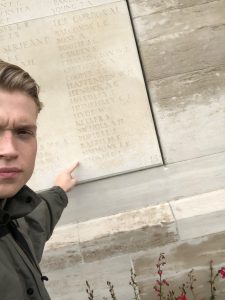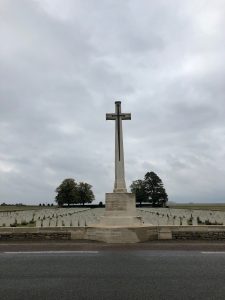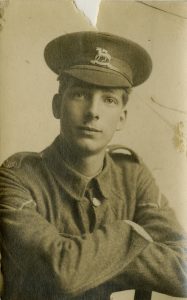During my current semester abroad, I got the chance to visit France. While staying in Paris, I planned two trips to the Somme and Loos battlefields.
On September 24th, I visited the Somme battlefields. I decided to travel by rail to Albert and then walk to the battlefields but travel delays related to a French railroad strike meant I only had time to see one memorial. I chose the Royal Newfoundland Memorial at Beaumont Hamel, as it was highly recommended by my relatives in Nova Scotia. When my train finally arrived at Albert, I started walking to Beaumont Hamel, a little over five miles away.
The walk to Beaumont Hamel took about an hour and a half. The time was well spent closely examining the French landscape. Anyone familiar with American battlefields cannot recognize the vast scale of French World War One battlefields. American battlefields, generally, are hemmed in by woods, hills, and rivers. There is an immediacy in the landscape that prevents large vistas. The countryside I walked through on the Somme was long, clear fields, climbing to booming ridges. The huge valleys cut between leviathan plateaus were vivid green running up to a steel contrast of the overcast sky. I could see clearly for miles, and somber memorials jutted hazily through the mist on the horizon. The Thiepval memorial, a structure no smaller than a four story mansion, sat over my shoulder on the far ridge, no bigger than a bottlecap.
However, this vast landscape was immediately contrasted by the tiny segments of the battlefield where individual battalions fought. The area where the Newfoundland Memorial is placed is roughly the size of a small city park or a large playground. The Memorial itself is a bronze caribou atop a landscaped mound, which can be surmounted by a footpath. The view from the top of the memorial reveals the entire frontage the Newfoundlanders occupied on July 1st, 1916. The labyrinth of trenches are preserved, with some open to the public. The memorial to the 51st Highland Division stands on the German frontline of July 1st and is parallel to the Newfoundland Memorial. There are two Commonwealth War Graves cemeteries to the left of the Memorial and another in the shallow valley to the right.
I was particularly struck by the actual distance between the Newfoundland frontline and the German wire. It is something of a cliché to write “the trenches were separated by only 100 yards” or “no man’s lands was no more than 50 meters” but to see those distances on a real landscape is jarring. I always imagined no man’s land as an endless moonscape of shell holes. At Beaumont Hamel, The Newfoundlanders and Germans were separated by a score of ugly little mounds. It was hard to conceptualize the immense human suffering that was enacted on this postage stamp of earth.

German frontline parallel to the Newfoundland Memorial. The 51st Highland Memorial is visible at center. Photograph by author.
The 1st Battalion Royal Newfoundland Regiment attacked on the afternoon of July 1st, 1916. The Newfoundlanders were in support when a white flare, the signal for reserves to come forward, arced over the German frontline. The Newfoundlanders advanced without hesitation. Tragically, the Germans also used white flares to call for artillery, and this was actually what the Newfoundlanders saw. The German defenders hammered the battalion with shellfire and lashed their right flank from a hidden machine gun nest. The Newfoundlanders were devastated. The battalion suffered over 80% casualties for no ground gained.
What this story looked like on the landscape did not match the gigantic tragedy I imagined. The area was so small and confined that it seemed like the titanic story couldn’t physically fit in the space. The small population of Newfoundland, around 150,000 in 1914, meant that the grievous losses endured at the Somme were disastrous for the community. The economy struggled, and Newfoundland became reliant on support from Great Britain. Newfoundland was demoted to the status of colony, and would not leave the empire to join Canada until 1946.
Despite the immense tragedy endured at Beaumont Hamel, the Newfoundland Memorial exudes a regional pride. Many historians mark the First World War as the first true surfacing of a Canadian/Newfoundland National identity. For many subjects of the British Empire, the Great War created an authentic sense of national distinctiveness. They began to see themselves as Australians, New Zealanders, Newfoundlanders, and Canadians, rather than subjects of the British Empire. That independent pride was born out of the tragedy enacted at places like Beaumont Hamel. Although Newfoundland regressed into colonial status, the region would never be the same after July 1st, 1916. Out of the suffering endured in such a small area, an entire region gained a sense of pride and identity on a global stage. A little place like Beaumont Hamel, on a huge landscape like the Somme, imparted a gigantic reputation to a rocky bit of coastline an ocean away.
I visited Loos on September 26th, on the 104th anniversary of the battle. Being in Loos on the anniversary was especially significant to me because the first project I completed for the First World War Letters of Jack Peirs was an interactive story map of the battle of Loos. I first walked from Vermelles to the Lone Tree. The Lone Tree was a landmark in no man’s land during the battle, and served as a rallying point for broken up British battalions.
Today’s Lone Tree is a squat, substantial cherry, replanted by an Anglo-German alliance in 1995 to commemorate the battle. The Lone Tree was northeast of the 8th Queen’s position on the 26th so I oriented myself with the village of Hulluch before me and Vermelles behind me. The landscape was open like the Somme, but without titanic humpbacked ridges. I was surrounded by fields planted with sugar beets, potatoes, and cabbage. Looking forward towards Hulluch, two ‘slag’ heaps gripped into the flat plain like huge black knuckles. The heaps are waste products of the local mines, and the Germans used them to observe the British during the battle. Looking back towards Vermelles, there were two cemeteries, identifiable by the tall white crosses stuck into the long green flats.

The landscape outside of Vermelles looking towards Lone Tree and the Loos Memorial. Photograph by author.
I livestreamed from the farthest cemetery, St. Mary’s Advanced Dressing Station, discussing the moment that 8th Queen’s went over the top for the first time. When I was done filming the livestream, I started walking through the rows, and was struck by the personalized messages left on many of the graves. The Commonwealth War Graves Commission, the organization charged with burying British and Dominion war dead of the First World War, enabled the families of identified soldiers to have personalized messages carved into the graves of their lost loved ones. One message in particular influenced the rest of my visit to Loos. The tombstone of R. Bailey, killed on September 26th, reads, “Sacred are the regions where your feet have trod.” The words it evoked a deepened reverence for the fields that rolled all round me. I found myself literally treading lightly over the fields where Bailey, and so many others, had fought, and fallen. I felt like a pilgrim visiting the tombs of saints.
I briefly visited Ninth Avenue Cemetery beyond St. Mary’s ADS, and then continued on to the Loos Memorial at Dud Corner. The Loos Memorial sits like a low fortress on a ridge outside Hulluch. The memorial is a small cemetery enclosed by granite walls that bear the names of the British dead whose bodies were never recovered. Many commemorated on the walls served in the 8th Queen’s. One of the names was very important to me personally, Lance Corporal Leonard Stovell. Gettysburg College Special Collections is in possession of Stovell’s personal papers and possessions, and while I was creating the Loos story map, Amy Lucadamo showed me the collection. The 8th Queen’s suffered 409 casualties on September 26th. I understood that 409 was a lot, but I didn’t understand the human cost until I saw Stovell’s face, his diploma from Wallingford Boy’s Academy, and the brass shoulder tabs he was likely wearing when he died. These objects made him a real person, who really lived, and really died at Loos. I featured Stovell in my storymap, and to see his name carved into stone, and the fields where he lost his life, completed the experience. I felt that a piece of the humanity lost 104 years to that day, had in some small way been recovered. I left the Loos Memorial, and returned to the Lone Tree, and livestreamed again before leaving the battlefield.

Pointing to Stovell’s name on the wall of the missing at the Loos Memorial at Dud Corner. Photograph by author.
My experiences at the Somme and Loos battlefields radically changed my perceptions of the First World War. The scale of the conflict, which was previously inconceivable to me, was represented physically in the landscape. I can now comprehend what was once unimaginable size. In this titanic landscape, I experienced the small human tragedies that created huge waves in history. The sacrifice of the 1st Battalion Royal Newfoundland Regiment on a spit of field in Northern France helped create a proud sense of identity among Newfoundlanders an ocean away. The inscription on R. Bailey’s grave at St. Mary’s ADS changed the way I viewed the battlefield, not only as a titanic landscape, but a site of pilgrimage. My own connection to Stovell that began in Gettysburg, was completed at the Loos Memorial when I touched the letters of Stovell’s name on the fields where he died. I would greatly recommend visiting the battlefields of the Somme and Loos. I know I will cherish my experiences on these fields for as long as I live.








